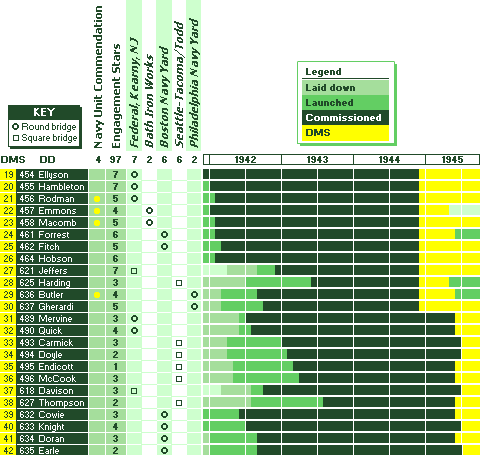Commencing on 9 November 1944, the eight surviving Gleaves-class destroyers of
DesRon 10 (excluding
Corry, which had been sunk at Normandy) plus DesRon 17’s
Jeffers,
Butler and
Gherardi and DesRon 18’s
Harding, entered navy yards for conversion as high-speed minesweepers—the
Ellyson class—and formed as
Mine Squadron 20.
In 1945, DesRon 15’s Mervine, Quick, Davison and DesDiv 30 (Cowie, Knight, Doran and Earle) plus DesRon 18’s Thompson and DesDiv 35 (Carmick, Doyle, Endicott and McCook) were also converted and organized as Mine Squadron 21.
These 24 ships were classified DMS and given hull numbers in sequence following the 18 flush-deck destroyer-minesweeper conversions.
LOSSES
Emmons was lost to suicide planes at Okinawa, where
Harding,
Forrest and
Butler were damaged and not repaired following the war.
DECORATIONS
Rodman,
Emmons,
Macomb and
Butler each received the Navy Unit Commendation for action off Okinawa. Before conversion,
Hobson as part of a USS
Bogue anti-submarine task group in the Atlantic, had earned the Presidential Unit Citation for the period April 1943–July 1944.
POST-WORLD WAR II
Unlike other 1,630-tonners, the twenty remaining DMSs were not decommissioned and placed in reserve or sold after World War II, but maintained in commission. They were thus available to serve in the Korean War, where
Carmick and
Thompson each earned the Navy Unit Commendation.
Hobson was rammed and sunk by Wasp (CV 18) on 26 April 1952. Others decommissioned in the mid-1950s and were placed in reserve with their destroyer armament restored or were sold to Japan or Taiwan. Some were used by Taiwan for spare parts; others were not stricken from the navy list and broken up until the late 1960s or early 1970s.

